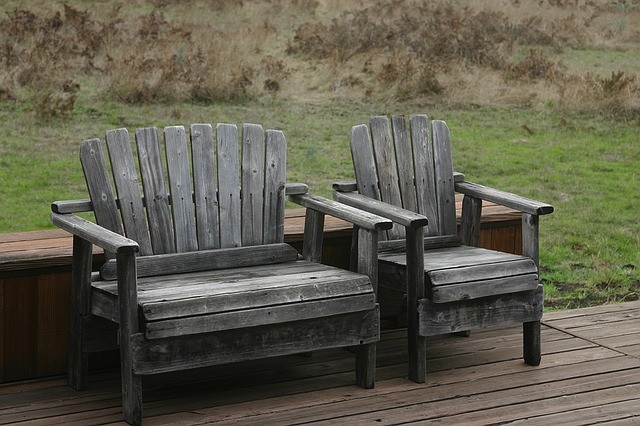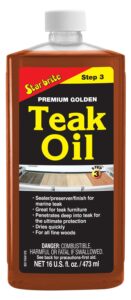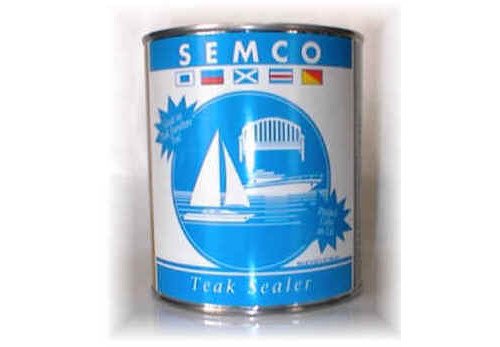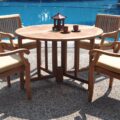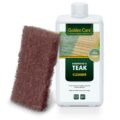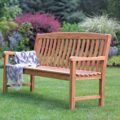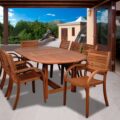Eucalyptus is one of the most popular woods for outdoor furniture. It looks beautiful and holds up to the elements wonderfully. But like any wood furniture kept outdoors, the color will eventually fade and become uneven, and dust and dirt will accumulate over time. Do you know how to restore eucalyptus furniture? If you own some of this lovely hardwood, you really should.
The changes in your eucalyptus furniture’s appearance will take place slowly, and so you might not even notice—until one day you compare the look of your dull grayed patio table with photos from the first week you bought it.
Wow, what a shock! Where did that warm, glowing color go?
The good news is you can get that brand new look back with a little bit of tender loving care. Once you know how to do it, restoring eucalyptus furniture is easy!
So if you’d like to know how to refinish eucalyptus patio furniture that has seen better days, keep reading…
Eucalyptus Wood Outdoor Furniture Care in 3 Easy Steps!
The 3 main steps to Eucalyptus hardwood furniture care or restoration are:
- Sanding
- Cleaning
- Treating
Do you need to follow all 3 steps? It depends on how old or neglected your furniture is.
If your furniture is brand new, and you simply want to protect it for the future, then you can skip to Step 3: Treating with an oil or wood seal finish.
If your wood furniture is in pretty good shape, and just needs a bit of a touch up, then you can skip the first step and start with Step 2: Cleaning.
However, if your patio furniture has been ignored for years and is looking quite rough—or the exterior is showing signs of discoloration—then it’s best to begin with Step 1: Sanding.
Materials for Eucalyptus Wood Furniture Restoration
First, you’ll need to prepare some or all of the following materials depending on how many steps you’ll follow:
- Orbital Sander
- 80 Grit Sanding Discs
- 150 Grit Sandpaper
- Protective Gloves
- Hardwood Cleaner/Brightener
- Scrub Pad
- Teak Oil or Teak Sealer
- Microfiber Cleaning Cloth
Step 1: Sanding
Perhaps you’ve picked up some secondhand patio furniture that has seen better days. You probably got a great deal on it because the original owner gave up on it too soon.
Many people don’t realize how easy it is to restore hardwood furniture to its former glory by sanding off a millimeter or so of the weathered exterior, thus exposing beautiful fresh wood to the world.
Begin by using the orbital sander and 80 grit sanding discs. It is truly an amazing process as the upper layer of tired-looking wood is ground away to reveal fresh new wood underneath.
Follow the electric sander up with 150 git sandpaper by hand. This lets you get every surface feeling smooth and slick to the touch.
I found this great video demonstrating what some sanding can do for an old outdoor table. He does a great job sanding, but then mixes his own wood polish at the end of the video, which I don’t particularly recommend. Instead, it’s going to be much easier and more effective to use a teak oil or teak sealer product as demonstrated in Step 3 below.
Step 2: Cleaning
If you began at Step 1 and sanded off the outer wood layer, then you don’t need to deep clean the wood surface, as it is already freshly exposed.
Rather, all you need to do is go over the wood thoroughly with a microfiber cloth to make sure you remove all of the dust particles created by sanding. Then you can go ahead and move on to treating the wood.
If, however, your furniture wasn’t looking all that nasty to begin with, you can start the care or restoration process with cleaning. To do it right, I recommend using a teak cleaner, such as Starbrite Teak Cleaner. Although formulated for teak, it works great on similar hardwoods such as eucalyptus.
Following the directions, you want to apply the cleaner to the wood, and then give it a little time to activate. Use a scrub brush to scrub the surface of the wood in the direction of the grain. Make sure to get inside all the little corners and gaps between wood slats, if your furniture has any.
Finally, rinse off the cleaner and wipe it dry with a clean cloth. Then allow another 24 hours to fully dry before treating with an oil, wood sealer, or other protectant.
Step 3: Treating
Once your furniture is fully dry and/or free of dust, you can begin treating the wood. The two best options for treating an outdoor eucalyptus furniture set are to use an oil or a wood sealer.
Best stain finish for for Eucalyptus wood?
If you’re wondering what the best stain for eucalyptus wood outdoor furniture is, I really would recommend NOT using a traditional wood stain product. Instead, my number one choice would be a wood sealer, and my second choice would be an oil treatment.
Teak oil for Eucalyptus
Generally, I don’t recommend using a teak oil on teak wood as it can interfere with the naturally occurring oils that already provide sufficient protection from moisture and pests. Eucalyptus wood, is very similar, and so I’m more prone to recommend using a sealer instead. However, there are a few teak oil formulations that actually work quite well.
There is a lot of variety in “teak oils”, since this is more of a marketing term than a scientific description. The best oil for eucalyptus wood furniture that I’ve found is Starbrite Premium Golden Teak Oil. The color protection that you get from it seems to last a lot longer than most.
You will probably want to use two coats. The oil can be applied with a clean microfiber cloth. Rub the oil in following the direction of the wood grain, and use just enough to fully coat. After letting it sit just a minute or so, you want to go over again with a fresh dry cloth to make sure there is no pooling of any oil. The surface should be free of any standing oil.
Come back the next day, and repeat the oiling process to give it a second coat. After you allow this to dry for 24 hours, you should be good to go for using your outdoor furniture.
Teak sealer for Eucalyptus
The other option I mentioned is to use a wood sealer, such as Semco Teak Sealer. I usually recommend this product for teak wood furniture over applying an oil, and it can work well for eucalyptus wood furniture, too.
The advantage is that the protection is usually longer-lasting and only needs to be repeated once a year. Whereas with an oil, you may want to repeat it every couple months to keep the wood looking its best.
The sealer can be applied with a sponge, cloth, brush, or spray canister. You want to use just enough to coat the surface completely. And again, allow a full 24 hours for it to dry.
So, it may be more convenient, but some people also prefer to “warmer” look of oiled wood.
You can decide for yourself which you’d prefer for your eucalyptus wood furniture restoration: oil or sealer.
As you can see, once you become familiar with how to restore eucalyptus wood furniture, it is not a difficult process. Just follow these simple steps and you can have your outdoor furniture looking like new.
In Conclusion: Bringing New Life to Your Eucalyptus Furniture
In the quest to restore your eucalyptus furniture to its former glory, you’ve embarked on a journey of transformation. The process, though it may seem daunting at first, is both rewarding and relatively simple to follow. By mastering the art of sanding, cleaning, and treating your outdoor eucalyptus furniture, you’re not merely reviving its appearance but extending its life for years of enjoyment.
Whether you opt for the richness of teak oil or the long-lasting protection of a wood sealer, the choice ultimately depends on your personal preference and maintenance schedule. Some favor the warm, natural look of oiled wood, while others appreciate the convenience and durability of a sealer. Whichever path you choose, the end result is the same: a stunning and resilient outdoor furniture set that beckons you to relax, entertain, and savor the beauty of your outdoor oasis.

